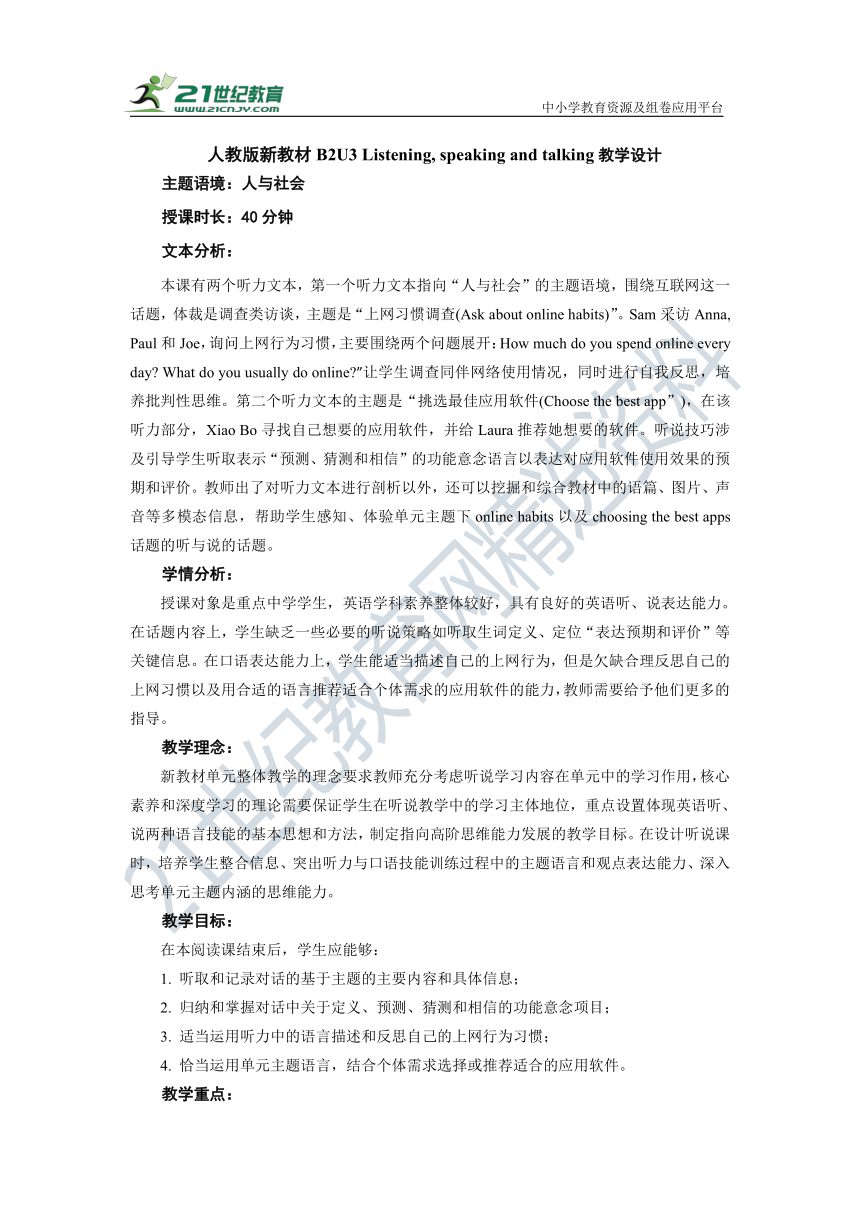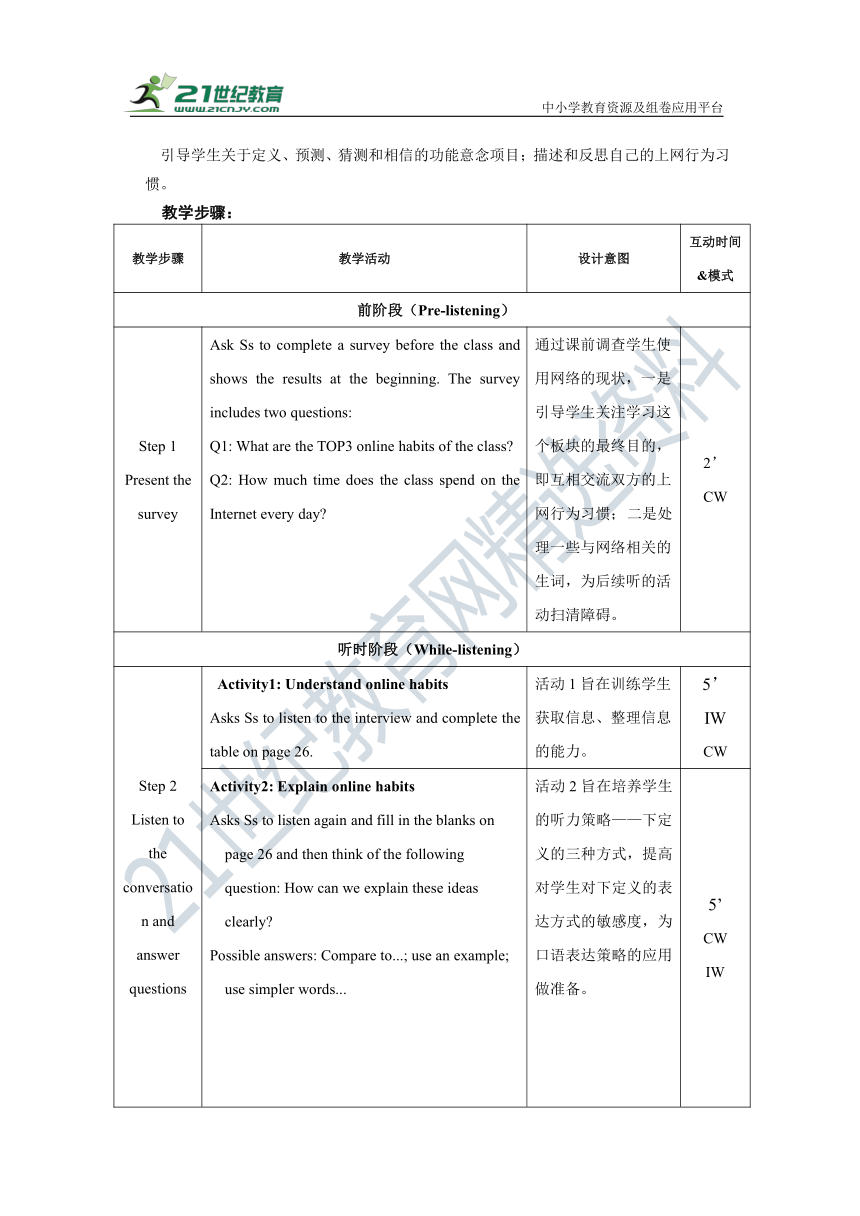人教版(2019)必修第二册 Unit 3 The internet Listening Speaking 教学设计
文档属性
| 名称 | 人教版(2019)必修第二册 Unit 3 The internet Listening Speaking 教学设计 |  | |
| 格式 | docx | ||
| 文件大小 | 141.2KB | ||
| 资源类型 | 试卷 | ||
| 版本资源 | 人教版(2019) | ||
| 科目 | 英语 | ||
| 更新时间 | 2024-09-20 20:06:45 | ||
图片预览


文档简介
中小学教育资源及组卷应用平台
人教版新教材B2U3 Listening, speaking and talking教学设计
主题语境:人与社会
授课时长:40分钟
文本分析:
本课有两个听力文本,第一个听力文本指向“人与社会”的主题语境,围绕互联网这一话题,体裁是调查类访谈,主题是“上网习惯调查(Ask about online habits)”。Sam采访Anna, Paul和Joe,询问上网行为习惯,主要围绕两个问题展开:How much do you spend online every day What do you usually do online ”让学生调查同伴网络使用情况,同时进行自我反思,培养批判性思维。第二个听力文本的主题是“挑选最佳应用软件(Choose the best app”),在该听力部分,Xiao Bo寻找自己想要的应用软件,并给Laura推荐她想要的软件。听说技巧涉及引导学生听取表示“预测、猜测和相信”的功能意念语言以表达对应用软件使用效果的预期和评价。教师出了对听力文本进行剖析以外,还可以挖掘和综合教材中的语篇、图片、声音等多模态信息,帮助学生感知、体验单元主题下online habits以及choosing the best apps话题的听与说的话题。
学情分析:
授课对象是重点中学学生,英语学科素养整体较好,具有良好的英语听、说表达能力。在话题内容上,学生缺乏一些必要的听说策略如听取生词定义、定位“表达预期和评价”等关键信息。在口语表达能力上,学生能适当描述自己的上网行为,但是欠缺合理反思自己的上网习惯以及用合适的语言推荐适合个体需求的应用软件的能力,教师需要给予他们更多的指导。
教学理念:
新教材单元整体教学的理念要求教师充分考虑听说学习内容在单元中的学习作用,核心素养和深度学习的理论需要保证学生在听说教学中的学习主体地位,重点设置体现英语听、说两种语言技能的基本思想和方法,制定指向高阶思维能力发展的教学目标。在设计听说课时,培养学生整合信息、突出听力与口语技能训练过程中的主题语言和观点表达能力、深入思考单元主题内涵的思维能力。
教学目标:
在本阅读课结束后,学生应能够:
听取和记录对话的基于主题的主要内容和具体信息;
归纳和掌握对话中关于定义、预测、猜测和相信的功能意念项目;
适当运用听力中的语言描述和反思自己的上网行为习惯;
恰当运用单元主题语言,结合个体需求选择或推荐适合的应用软件。
教学重点:
引导学生关于定义、预测、猜测和相信的功能意念项目;描述和反思自己的上网行为习惯。
教学步骤:
教学步骤 教学活动 设计意图 互动时间&模式
前阶段(Pre-listening)
Step 1 Present the survey Ask Ss to complete a survey before the class and shows the results at the beginning. The survey includes two questions: Q1: What are the TOP3 online habits of the class Q2: How much time does the class spend on the Internet every day 通过课前调查学生使用网络的现状,一是引导学生关注学习这个板块的最终目的,即互相交流双方的上网行为习惯; 二是处理一些与网络相关的生词,为后续听的活动扫清障碍。 2’ CW
听时阶段(While-listening)
Step 2 Listen to the conversation and answer questions Activity1: Understand online habits Asks Ss to listen to the interview and complete the table on page 26. 活动1旨在训练学生获取信息、整理信息的能力。 5’ IW CW
Activity2: Explain online habits Asks Ss to listen again and fill in the blanks on page 26 and then think of the following question: How can we explain these ideas clearly Possible answers: Compare to...; use an example; use simpler words... 活动2旨在培养学生的听力策略——下定义的三种方式,提高对学生对下定义的表达方式的敏感度,为口语表达策略的应用做准备。 5’ CW IW
Activity3: Practice sentence stress Listen again and underline the stress of sentences. 活动3旨在培养学生的口语表达策略,引导学生根据听力内容划出句中的实词,帮助学生既关注了信息,也关注了语言。这个活动巧妙之处在于承上启下,为后续学生要进行的口语表达做了铺垫。 5’ IW GW CW
听后阶段(post-listening)
Step3: Share online habits What are your online habits Share in pairs. 该活动旨在引导学生基于所学表达自己的网络习惯。 2’ GW
听前阶段(pre-listening)
Step 4 Identify different needs Shares the survey results concerning the distribution of popular apps in class and asks Ss to identify different needs. 激起学生的兴趣,导入听力活动的主题——根据个人需求挑选最佳应用软件。 2’ IW CW
听时阶段(While-listening)
Step 5 Compare different apps Activity 1: Listen to the conversation and complete the files of Xiao Bo and Laura respectively. 活动1训练学生根据听力主要内容的理解,即Xiao Bo和Laura对于选择合适的应用软件的不同观点,引导学生思考他们真实的需求。 5’ GW CW
Activity 2: Listen again and find supporting sentences. Q1: What are their comments on each app Q2: What’s your favor when choosing similar apps 活动2旨在引导学生关注表达预期,猜想和相信时所需要的功能意念项目(虚拟语气)。该活动的设计体现了为学生口语表达搭建支架的原则。 5’ GW CW
听后阶段(post-listening)
Step 6: Evaluate your own online habits Activity1: Evaluate online habits Review the results of the survey again and think of the following questions. Q1: What do you think of your own online habits Q2: Do I only use the Internet as an entertainment tool Q3: Do I spend too much time online Q4: Do I need to change my online habits 引导学生批判性思考在互联网时代下如何正确使用网络资源,把网络当成促进自身成长和提高综合素养的工具。 3’ IW GW
Activity2:Deliver a report Make a report for your online habits and evaluate the report based on self-checklist. 将零散的信息整合成口头报告,是对口语表达内容的再加工,学生需要理解、概括、综合运用自己的语言,甚至需要转换时态、文体等进行口语表达。 5’ IW
Step 8: homework Required: Practice your oral report on My Online Habits. Optional: Share learning apps with each other and get ready to recommend them in class. 依托建构创造类活动,迁移、运用主题内容及语言。 1’ GW CW
备注:Ss: Students IW: Individual work GW: Group work CW: Class work
人教版新教材B2U3 Listening, speaking and talking教学设计
主题语境:人与社会
授课时长:40分钟
文本分析:
本课有两个听力文本,第一个听力文本指向“人与社会”的主题语境,围绕互联网这一话题,体裁是调查类访谈,主题是“上网习惯调查(Ask about online habits)”。Sam采访Anna, Paul和Joe,询问上网行为习惯,主要围绕两个问题展开:How much do you spend online every day What do you usually do online ”让学生调查同伴网络使用情况,同时进行自我反思,培养批判性思维。第二个听力文本的主题是“挑选最佳应用软件(Choose the best app”),在该听力部分,Xiao Bo寻找自己想要的应用软件,并给Laura推荐她想要的软件。听说技巧涉及引导学生听取表示“预测、猜测和相信”的功能意念语言以表达对应用软件使用效果的预期和评价。教师出了对听力文本进行剖析以外,还可以挖掘和综合教材中的语篇、图片、声音等多模态信息,帮助学生感知、体验单元主题下online habits以及choosing the best apps话题的听与说的话题。
学情分析:
授课对象是重点中学学生,英语学科素养整体较好,具有良好的英语听、说表达能力。在话题内容上,学生缺乏一些必要的听说策略如听取生词定义、定位“表达预期和评价”等关键信息。在口语表达能力上,学生能适当描述自己的上网行为,但是欠缺合理反思自己的上网习惯以及用合适的语言推荐适合个体需求的应用软件的能力,教师需要给予他们更多的指导。
教学理念:
新教材单元整体教学的理念要求教师充分考虑听说学习内容在单元中的学习作用,核心素养和深度学习的理论需要保证学生在听说教学中的学习主体地位,重点设置体现英语听、说两种语言技能的基本思想和方法,制定指向高阶思维能力发展的教学目标。在设计听说课时,培养学生整合信息、突出听力与口语技能训练过程中的主题语言和观点表达能力、深入思考单元主题内涵的思维能力。
教学目标:
在本阅读课结束后,学生应能够:
听取和记录对话的基于主题的主要内容和具体信息;
归纳和掌握对话中关于定义、预测、猜测和相信的功能意念项目;
适当运用听力中的语言描述和反思自己的上网行为习惯;
恰当运用单元主题语言,结合个体需求选择或推荐适合的应用软件。
教学重点:
引导学生关于定义、预测、猜测和相信的功能意念项目;描述和反思自己的上网行为习惯。
教学步骤:
教学步骤 教学活动 设计意图 互动时间&模式
前阶段(Pre-listening)
Step 1 Present the survey Ask Ss to complete a survey before the class and shows the results at the beginning. The survey includes two questions: Q1: What are the TOP3 online habits of the class Q2: How much time does the class spend on the Internet every day 通过课前调查学生使用网络的现状,一是引导学生关注学习这个板块的最终目的,即互相交流双方的上网行为习惯; 二是处理一些与网络相关的生词,为后续听的活动扫清障碍。 2’ CW
听时阶段(While-listening)
Step 2 Listen to the conversation and answer questions Activity1: Understand online habits Asks Ss to listen to the interview and complete the table on page 26. 活动1旨在训练学生获取信息、整理信息的能力。 5’ IW CW
Activity2: Explain online habits Asks Ss to listen again and fill in the blanks on page 26 and then think of the following question: How can we explain these ideas clearly Possible answers: Compare to...; use an example; use simpler words... 活动2旨在培养学生的听力策略——下定义的三种方式,提高对学生对下定义的表达方式的敏感度,为口语表达策略的应用做准备。 5’ CW IW
Activity3: Practice sentence stress Listen again and underline the stress of sentences. 活动3旨在培养学生的口语表达策略,引导学生根据听力内容划出句中的实词,帮助学生既关注了信息,也关注了语言。这个活动巧妙之处在于承上启下,为后续学生要进行的口语表达做了铺垫。 5’ IW GW CW
听后阶段(post-listening)
Step3: Share online habits What are your online habits Share in pairs. 该活动旨在引导学生基于所学表达自己的网络习惯。 2’ GW
听前阶段(pre-listening)
Step 4 Identify different needs Shares the survey results concerning the distribution of popular apps in class and asks Ss to identify different needs. 激起学生的兴趣,导入听力活动的主题——根据个人需求挑选最佳应用软件。 2’ IW CW
听时阶段(While-listening)
Step 5 Compare different apps Activity 1: Listen to the conversation and complete the files of Xiao Bo and Laura respectively. 活动1训练学生根据听力主要内容的理解,即Xiao Bo和Laura对于选择合适的应用软件的不同观点,引导学生思考他们真实的需求。 5’ GW CW
Activity 2: Listen again and find supporting sentences. Q1: What are their comments on each app Q2: What’s your favor when choosing similar apps 活动2旨在引导学生关注表达预期,猜想和相信时所需要的功能意念项目(虚拟语气)。该活动的设计体现了为学生口语表达搭建支架的原则。 5’ GW CW
听后阶段(post-listening)
Step 6: Evaluate your own online habits Activity1: Evaluate online habits Review the results of the survey again and think of the following questions. Q1: What do you think of your own online habits Q2: Do I only use the Internet as an entertainment tool Q3: Do I spend too much time online Q4: Do I need to change my online habits 引导学生批判性思考在互联网时代下如何正确使用网络资源,把网络当成促进自身成长和提高综合素养的工具。 3’ IW GW
Activity2:Deliver a report Make a report for your online habits and evaluate the report based on self-checklist. 将零散的信息整合成口头报告,是对口语表达内容的再加工,学生需要理解、概括、综合运用自己的语言,甚至需要转换时态、文体等进行口语表达。 5’ IW
Step 8: homework Required: Practice your oral report on My Online Habits. Optional: Share learning apps with each other and get ready to recommend them in class. 依托建构创造类活动,迁移、运用主题内容及语言。 1’ GW CW
备注:Ss: Students IW: Individual work GW: Group work CW: Class work
